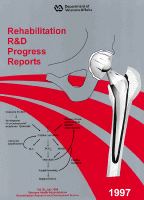
A diagram illustrates the hypothetical chain of events proposed to occur in aseptic loosening of artificial total hip joint replacements. This VA-funded research, entitled, "Biochemical Analysis of Synovial Activation in Joint Dysfunction," is the work of Christopher H. Evans, PhD, VAMC, Pittsburgh, PA. Dr. Evans' hypothesis is: components of prosthetic hip joints shed wear particles. These interact with the surrounding tissues, provoking cellular activation. Activated cells then secrete high levels of Matrix Metalloproteinase (MMP), prostaglandin E2 (PGE2) and interleukin-1 (IL-1), which provoke the local resorption of bone. This mechanically weakens the bone surrounding the implant, leading to aseptic loosening. IL-1 is likely to be an important autocrine amplifier of this process. A radical new approach to the problem of aseptic loosening of prosthetic joints is being investigated--the use of gene therapy.
This research is sponsored by the Department of Veterans Affairs, Rehabilitation Research and Development Service, John R. Feussner, MD, Chief Research and Development Officer, VA Headquarters, Washington, DC.
THE EDITOR
Cover design and production by Frank Vanni, Scientific and Technical Publications Section, Rehabilitation Research and Development Service, Department of Veterans Affairs, Baltimore, MD.
Go to top.
Last revised Fri 04/30/1999